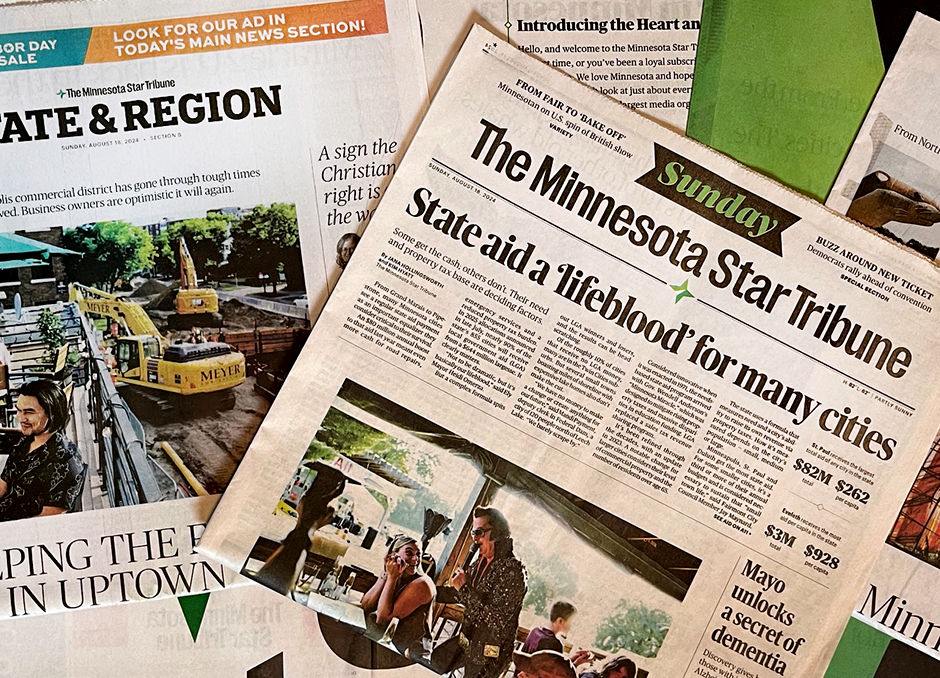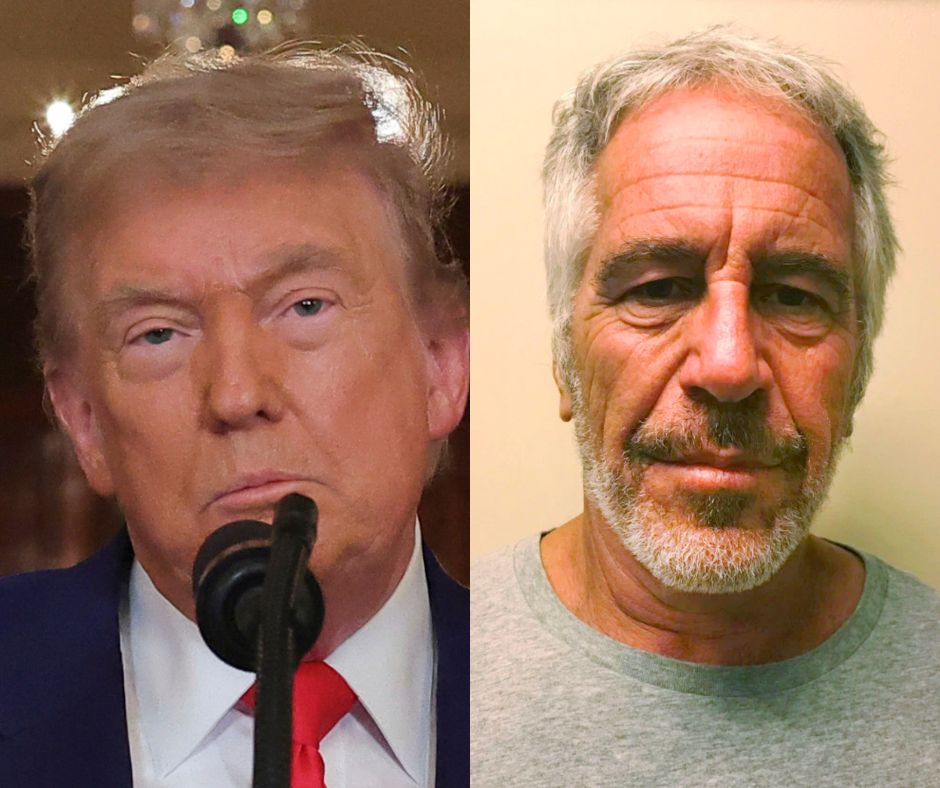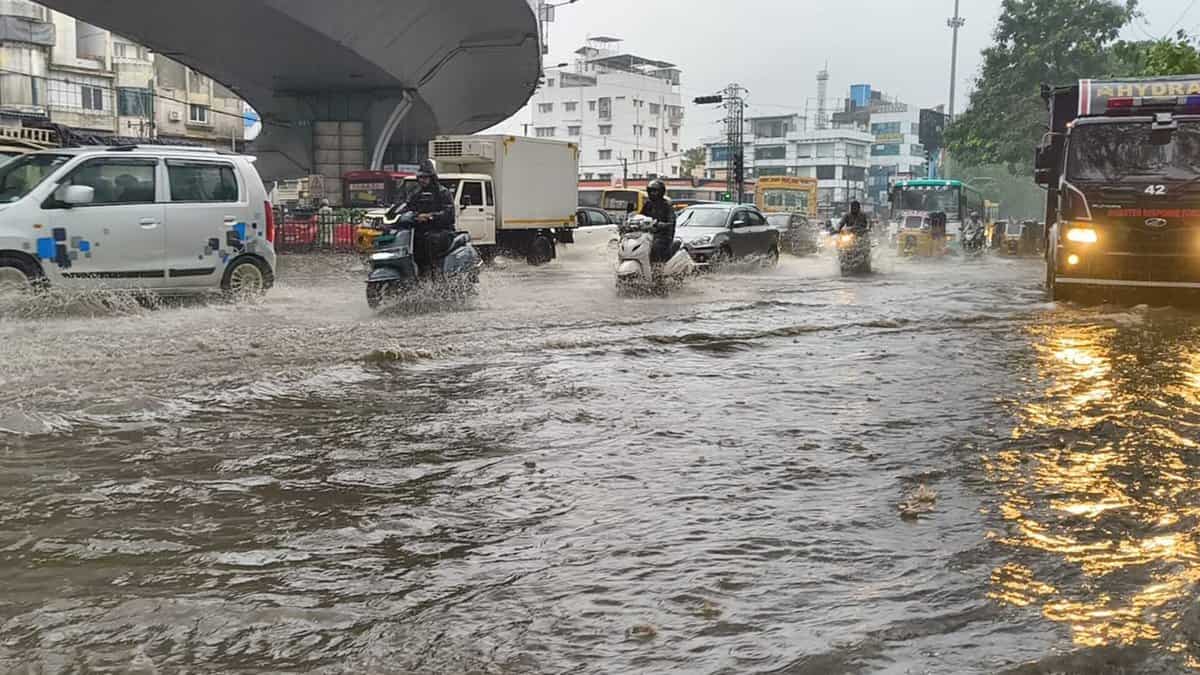


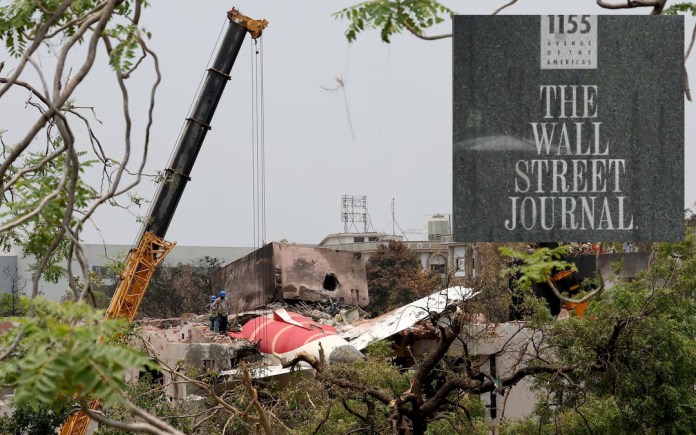
The Air India 787-8 Dreamliner aircraft manufactured by Boeing crashed on 12th June 2025 in Ahmedabad just after take off. Over 250 people died in this accident, leaving a lone survivor. While the Indian authorities are investigating the cause behind the deadly crash, the US-based newspaper The Wall Street Journal has already blamed the Air India pilots. The American media’s haste to blame the Indian pilots reeks of Boeing’s well-worn playbook: deflect, distract and dodge accountability even before the facts land.
The Wall Street Journal article published on 10 July 2025 essentially absolved the US-based Boeing of any fault in the Dreamliner’s crash. Amusingly, the newspaper cited US officials to make this assertion.
“The investigation into last month’s Air India crash is focusing on the actions of the jet’s pilots and doesn’t so far point to a problem with the Boeing 787 Dreamliner, according to people familiar with U.S. officials’ early assessments,” the WSJ propaganda article reads.
The WSJ article posits that the two highly experienced Indian pilots Captain Sumeet Sabharwal and First Officer Clive Kunder, with the former having over 10,000 hours of flying time and the latter of around 3400 hours, intentionally or inadvertently turned off the fuel switches to both engines shortly after take-off, leading to a catastrophic loss of thrust and subsequent crash of the Boeing aircraft.
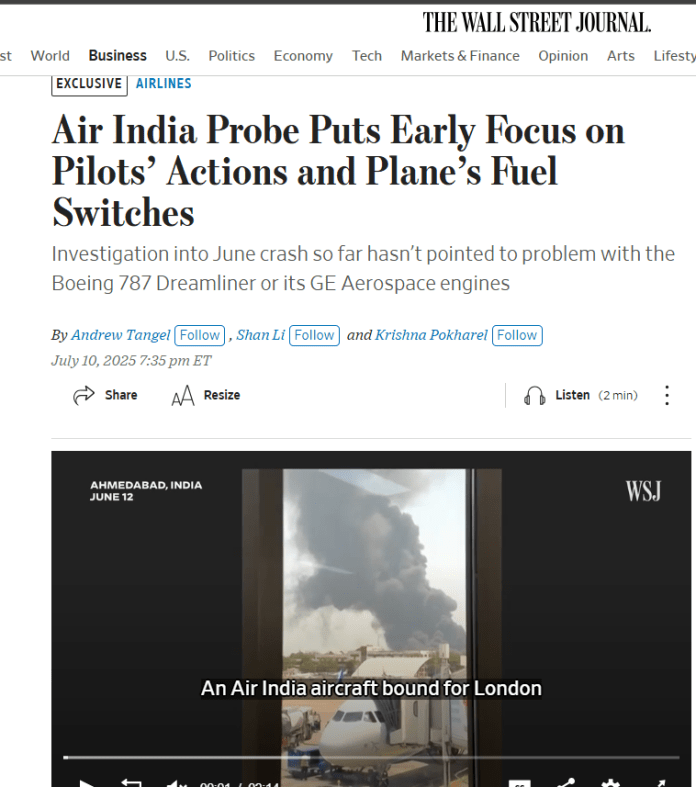
“The switches would normally be on during flight, and it is unclear how or why they were turned off, these people said. The people also said it was unclear whether the move was accidental or intentional, or whether there was an attempt to turn them back on,” the WSJ article claims.
Very shrewdly, the Wall Street Journal weaved a narrative based on its speculations to hand over a clean chit to Boeing and engine maker GE even before the release of the preliminary report by India’s Aircraft Accident Investigation Bureau (AAIB). Given Boeing’s opprobrious history of cover-ups and its fraught friendship with public trust, the timing of the WSJ’s propaganda piece raises serious questions.
Has Boeing unleashed its propaganda machinery ahead of the release of AAIB’s preliminary investigation report? Are Indian pilots who are not alive to defend themselves or present their version of events being blamed because there were indeed faults in the Boeing plane or GE engines?
After casting aspersions on the efficiency and integrity of the deceased Indian pilots, the WSJ proceeded to eulogise the Boeing Dreamliner and that there was no “problem with that model aircraft or its GE engines.”
Interestingly, WSJ is not the only media outlet that has pushed a pro-Boeing narrative; in fact, a section of the media is concocting a loop of potential lies to protect the US-based aerospace company.

The Air Current also claimed that the “data available to the investigators does not indicate a mechanical or design issue with the 787 or its two GE Aerospace GEnx-1B engines. The TAC report suggested that since Boeing or GE did not issue any advisory or a multi-operator message (MOM) to operators in the 13 days that have followed the initial black box reading 2 in Delhi by the AAIB on June 25, there is little possibility of a mechanical failure. This, however, is nothing but speculation.

Unsurprisingly, many foreign news outlets like the ABC, Reuters, Gulf News and Indian media outlets like NDTV, CNBC and Indian Express have amplified the claims made in the TAC and WSJ report even as these claims are speculation driven and may have little to do with the actual findings of the AAIB’s preliminary report expected to be released on 11th July.
All these reports rely on anonymous US-based sources to emphasise pilot actions without any conclusive evidence. The lack of urgent mechanical advisories does not essentially rule out aircraft issues, as investigations take months to identify subtle issues. The timing of these reports, just before the AAIB’s preliminary findings are expected to be out, suggests that these reports have been deliberately put out with the intention of shaping public perception in favour of Boeing while scapegoating the deceased Indian pilots.
Unfortunately, earlier as well, the TRP-hungry Indian television anchors like Rajdeep Sardesai decided to platform an American TikToker and self-proclaimed aviation expert named Captain Steve Scheibner to determine the cause of the crash. Appearing on multiple Indian news channels after the tragedy, Captain Steve, a former US Navy pilot and self-proclaimed aviation expert, peddled a conspiracy theory that the pilots may have accidentally retracted the flaps instead of the landing gear during the initial climb. He described this as “a tragic mistake.”
This was when neither the black box nor the voice recorder was recovered. The Indian mainstream media did not even properly question the basis of Captain Steve’s conspiracy theory, blaming pilots who are not even alive to defend themselves.
Besides blaming the pilots, Captain Steve also suggested power loss, fuel contamination, a bird strike, or flap configuration error as possible causes behind the crash. After new evidence surfaced, especially a clearer video showing the deployment of the ram air turbine (RAT) on the aircraft, Captain Steve quickly shifted his stance. However, he had to face no consequences for peddling conspiracy theories and tarnishing the reputation of the highly experienced pilots who lost their lives in the deadly crash.
Not only IndiaToday, but CNBC-TV18, and several other mainstream media channels invited the American pilot-turned-TikToker to blame Air India pilots without a shred of evidence. Advertently or inadvertently, the Indian media has been pushing a Boeing-friendly agenda, which obviously aims to deflect scrutiny from mechanical or manufacturing issues.
Lobbying, coverups and accidents: Boeing has mastered the art of dodging accountability
Notably, the catastrophic incident has once again highlighted Boeing’s association with yet another tragic aviation event. Its stock was down about 5% on 12th June when New York stock markets closed. Last year, the company struggled with a safety crisis, quality control problems and a disastrous seven-week strike by the workers that cost it around $1 billion each month.
Boeing continues to cope with the fallout from two fatal crashes involving its 737 Max aircraft in 2018 and 2019, which claimed 346 lives. Earlier this year, the firm and the Department of Justice came to an agreement that would exempt it from criminal liability for the crashes.
Boeing is an American aerospace company, and a large part of its income comes from contracts from the US government. Boeing makes many military aircraft for America. Apart from this, the rules and policies of America apply to Boeing. It spends thousands of crores to ensure that these American policies work in its favour.
A report by the US stock market regulator SEC says that Boeing has spent more than $200 million (₹1700 crore+) on lobbying from 2010-2022. $26 million (₹225 crore) has been spent in 2021 and 2022 alone. A report by the SEC itself shows that Boeing has spent more than $320 million (₹2700 crore) on lobbying since 1998. The SEC says that Boeing ranks 9th in terms of spending on lobbying within the US.
Boeing is at number 9 in this arena, while in terms of market cap, it is at number 70-80 in America. This simply means that Boeing spends much more than its status on lobbying. Boeing gives money to both parties in America, i.e. Democrats and Republicans, to bend the rules according to its wishes.
Boeing’s history of controversies lends credence to suspicions of a coordinated blame-shifting effort. The US-based company faced intense scrutiny after the 2018 Indonesian Lion Air Flight 610 and 2019 Ethiopian Airlines Flight 302 involving the Boeing 737 Max, which killed hundreds of people. These deadly crashes were linked to flaws in the Manoeuvring Characteristics Augmentation System (MCAS) and other reasons.
It was revealed that in both accidents, MCAS continued to push the plane down while the pilots kept trying to fly it. The pilots failed in this, and this faulty system brought the plane down. When the pressure increased after the investigation of both accidents, Boeing admitted that it had hidden this information. Boeing admitted that it had not told the pilots about this new system. Gplus reported in detail how Boeing bends the US laws to its whims and exploits loopholes to keep its profits soaring even at the cost of human lives. Boeing’s lobbying isn’t confined to the commercial sector.
The Boeing 737-800 operated by China Eastern Airlines crashed and caught fire in Guangxi province when it was en route from Kunming to Guangzhou in March 2022. President Xi Jinping ordered a swift investigation to find out the reason behind the incident, which stunned the country. Afterwards, every 737-800 operated by China Eastern Airlines was grounded.
According to the Civil Aviation Administration of China (CAAC), Beijing disagreed with Boeing’s initial explanation of pilot error and blamed the crashes on a malfunctioning Manoeuvring Characteristics Augmentation System (MCAS) design.
A Jeju Air flight 7C2216 belly-landed and went off the end of the runway at Muan International Airport in December 2024, smashing into a wall and exploding. Four of the six crew members and all 175 passengers on board were killed, while two crew members were hauled out unharmed. South Korean authorities then declared that they would conduct an urgent safety check on every Boeing 737-800 aircraft operated by the country’s airlines.
Last November, a cargo plane crashed close to Vilnius airport in Lithuania, resulting in at least one fatality and three injuries. During its final approach for landing, the Spanish cargo airline Swiftair, operating a Boeing 737 for DHL (Dalsey, Hillblom and Lynn), crashed close to a residence.
A Boeing 737 Max 9 plane’s unused cabin door fell off in midair in January, generating a stir in the aviation industry.
The company also has a significant presence in defence manufacturing, and even there, it has been accused of corruption.
Despite a litany of corruption allegations and a disturbing string of accidents tied to mechanical failures of Boeing aircraft, the US government continues to shield the company, enabling it to evade accountability. With a pliant media at its disposal, Boeing has mastered the art of deflecting blame, shrewdly spinning narratives to protect its reputation and interests while conveniently evading the scrutiny its alarming track record warrants.








